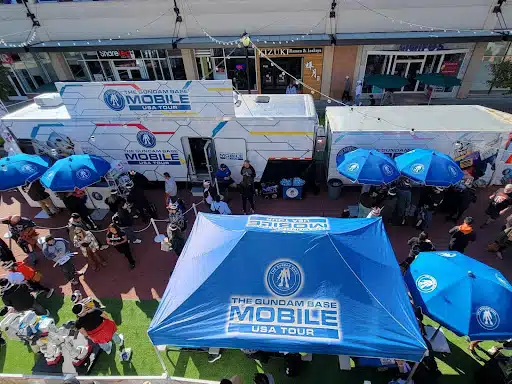Today’s consumers are always plugged in, so digital marketing may seem like the easiest way to reach customers. Yet, think about all the advertising messages your audience is bombarded with daily. This digital clutter is a stream of never-ending marketing messages, across dozens of devices and platforms. Information overload leads to banner blindness — consumers ignore or don’t even register banner ads they see on the internet. Consider the last time you scrolled through Instagram. You probably encountered dozens of ads, but most likely you quickly scroll past them to get to the next post. This is especially true for younger consumers. While Gen-Zers spend an average of 4 hours per day online, they prefer in-person experiences to traditional advertising.
The numbers speak for themselves. According to Havas 2019 “Meaningful Brands” study, consumers think 58% of content from brands is irrelevant and isn’t meaningful. A survey in 2018 revealed that 41% of marketers believe events are the most effective marketing channel over digital advertising, email marketing, and content marketing. The same study reported that an astounding 95% of business owners feel that live events are the best way to engage consumers in today’s digital world. It is clear why experiential marketing is a successful approach: 50% to 80% of word-of-mouth activity is the result of a consumer’s direct experience with a product or service. 65% of customers say that product demos and live events helped them understand the product better than any other advertising method. Live events allow for demonstrations and experiences that digital marketing can’t offer.
Still not feeling convinced? Listed below are 5 ways that experiential marketing cuts through digital clutter:
- Experiential marketing is immersive
The 2018 Edelman Earned Brand study found that consumers want to support brands that provide immersive experiences. As we’ve written about previously, one of the top benefits of experiential marketing is that it can tap into all 5 senses, leading to a totally immersive experience. In contrast, digital ads tap into sight and sometimes sound.
Experiences that are truly immersive are more memorable than ones that tap into only one sense. Why is this? As humans, we gradually stop responding to stimuli after regular exposure – a process known as habituation. This is the phenomenon that allows you to see something without processing it. As an example, think about the times you’ve driven yourself home and realized you don’t remember most of the drive. You were probably safe — you are just so habituated to the route that you aren’t mentally engaged! To break through this obstacle, think about the 5 senses and consider which aligns most with your branding. Consider how you can incorporate taste, smell, and touch into an experience.
2. Experiential marketing lets you go to your audience
Unlike digital advertisements that can feel intrusive, real-life experiences allow customers to opt-in to hearing your message. Individuals who opt-in are already more open to interacting with you. Experiential marketing can be adapted in so many ways, you can easily take your message where your audience lives, works, plays, or shops — parks, fairs, other businesses, the options are practically endless. The kind of ad targeting that is often associated with social media is not unique to digital platforms, either. Once you identify your target audiences, you can figure out what will resonate with them. Experiential programs can be targeted to times or locations when customers are in the right frame of mind. For example, a food-based event will resonate more when people are hungry and rushed after work, versus seeing an advertisement for the same brand when they are scrolling through their phone before bed. As Pro Motion CEO Steve Randazzo stated on the Talk Experiential Podcast, the key to engaging anyone is “to catch them at the right time, and the right place, and when they’re open.”
3. Experiential marketing is perfect for demonstrating corporate responsibility
Another way to stand out from the rest of the digital clutter is to communicate to your audience that you care about giving back. Corporate social responsibility programs, or CSR, allow your brand to communicate you care about more than profit. For instance, Target and KaBOOM!, an organization that provides playground equipment to underserved communities, paired up for a program to encourage safe, rewarding play for kids in four major cities. Target got fully involved in giving back to communities. Store personnel helped build immersive experiences and engaged parents. This was an excellent way to show Target’s audience how much it cares about locals’ well-being.
4. Experiential marketing is memorable
Do you remember the last tweet you read? If it was particularly funny – and therefore memorable – maybe you do. What about which specific tweets you read yesterday? Last week? A great advantage of experiences is that these memories last far longer than the average digital impression. You likely have better memory of an incredible concert you attended 5 years ago than you do of what digital ads you’ve seen recently. Simply put, experiences are memorable – digital clutter is not. Most digital posts are unlikely to lead to an emotional connection with your audience. In an age when consumers can buy virtually anything online, in-person experiences are much more memorable. Experiential marketing provides the sensory, emotional, and cognitively engaging experiences that create lasting bonds between brands and consumers.
5. Experiential marketing demonstrates a brand’s value
Remember, customers report that live events and product demonstrations best help them to understand a product. Why do customers value live events more than other forms of advertising? The Havas “Meaningful Brands” study showed that while consumers expect content that “educates” them, most brands are fixated on content that is “entertaining.” Most content fails to explain the impact of a service or product on customer’s lives. Of course, experiential marketers must also be careful not to focus too much on “wow” events that are simply entertaining,without components that educate, inspire, and inform their audiences. Luckily, it is much easier to connect with consumers individually about how a brand specifically relates to their lives when you have great brand ambassadors to make those connections with consumers.
Bonus: You don’t have to give up on digital!
The use of experiential marketing doesn’t rule out using digital platforms. In fact, many brands find that integrating their digital content with experiential programming leads to the most success. For instance, apparel brand Bonobos created nontraditional physical retail stores that allowed customers to touch products that are only for sale online. After trying the selection in-person, customers can place an order online from the store. Bonobos demonstrates a perfect pairing of the ease of online shopping, and the value added by experiencing a brand in person.
Want to learn more from an accomplished experiential marketing agency with 25 years of experience? Pro Motion is an industry leader in creating engaging, effective campaigns. Give us a call at 636-577-8507
Learn More About Experiential Marketing from PMI President Steve Randazzo in his book Brand Experiences: Building Connections in a Digitally Cluttered World. Click here to download 2 free chapters!




